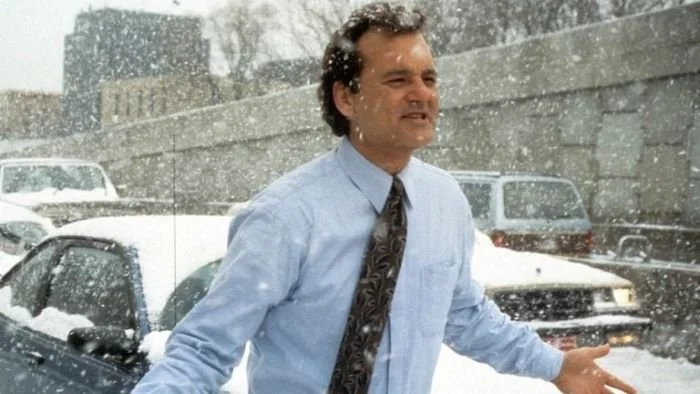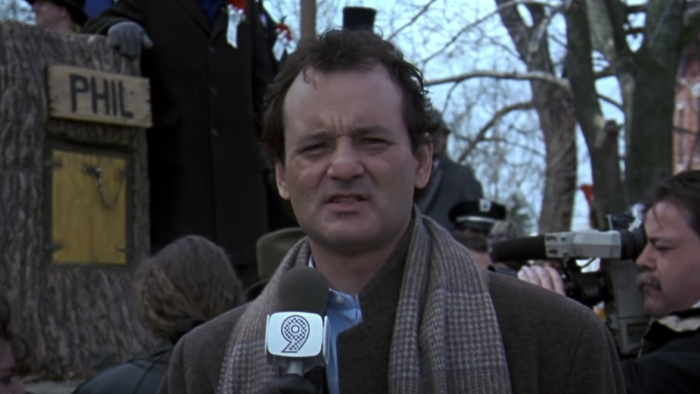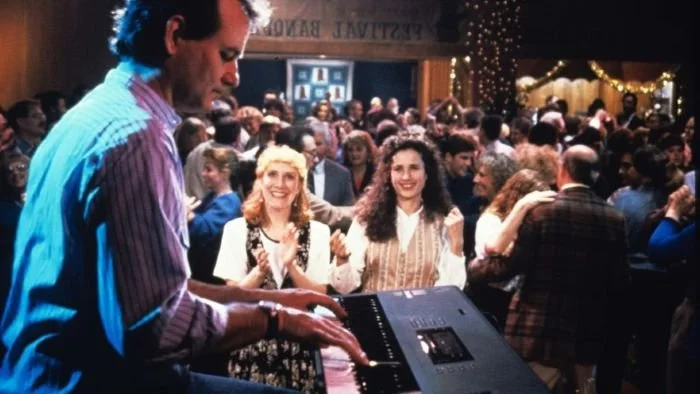On Death And Dying And ‘Groundhog Day’
Image Source: TV Insider
The 1993 romantic-comedy movie Groundhog Day featured Bill Murray as Phil Connors, a cynical and misanthropic weatherman assigned to travel to Punxsutawney, Pennsylvania, along with his producer, Rita (Andie McDowell), and cameraman, Larry (Chris Elliott), to cover the annual Groundhog Day festivities. On their way home, a sudden blizzard forced them to turn back to Punxsutawney. When he wakes up the next day and prepares to leave town, Phil finds that it is, inexplicably, Groundhog Day again and begins to experience the same events from the “previous” day. He continues to relive the same day over and over again, restarting at 6:00 AM to the tune of Sonny and Cher’s “I Got You Babe.” The film has become a classic, with some television stations playing it on a loop every Groundhog Day. It has also become synonymous in our culture with the feeling of doing the same thing every single day.
As Phil goes through each day, his response to the daily events begins to shift in a manner that reminded me, unintentionally or not, of Dr. Elisabeth Kubler-Ross’s model in her 1969 book, On Death and Dying. The book explored death through the lives of terminally ill patients and represented a cultural shift in discussions about death and dying, which were previously considered taboo. This led to changes in how terminally ill patients are cared for in their final days. While the model originally referred to how terminally ill patients come to terms with their own deaths, it has now been applied to grieving family and friends in what is popularly known as the five stages of grief: denial, anger, bargaining, depression, and acceptance. Phil’s reactions to his new and unexpected circumstances shift through these five stages until he finally accepts his fate and is thus “reborn” as a changed person.
RELATED:
Denial
Phil argues the existence of the blizzard
Image Source: Reader’s Digest
When people learn that they are terminally ill, one of their first reactions is typically denial or rejection of their new reality. As Phil relives the same day the first few times, he is, understandably, caught completely off-guard. At first, he thinks that the radio station is just playing a joke, repeating the same broadcast from the previous day. He cannot believe that the snow from “yesterday’s” blizzard is suddenly gone. He actually tries to argue with a state trooper that the incoming winter storm that will eventually trap them in Punxsutawney is not even a blizzard, and tries to find other ways to get home. Phil is baffled to see people heading out to Gobbler’s Knob for the Groundhog Day festivities again. Even though he still does not understand what is going on, Phil is forced to relive the day’s events again.
Anger
Phil becomes angry about his predicament
Image Source: HITC
Once the reality of dying and their new circumstances become impossible to ignore, terminally ill patients react by lashing out at others. Finding no answers and no solution to his strange predicament, Phil becomes more agitated and irritated at everybody. He picks up a fellow hotel guest by his coat and angrily demands to know what is going on. He shoves a former classmate who approaches him to try to say hi and sell him insurance. Phil becomes more cynical and acerbic than usual towards his producer and cameraman, who have no clue what has gotten into him.
Bargaining
Phil kidnaps “Phil” in the hopes of not having to relive the same day anymore
Image Source: Morgan County Citizen
Bargaining is when terminally ill patients attempt to exert some control over their situation and try to find ways to avoid or possibly even change their fate. Seeking answers to his strange situation, Phil seeks out both a doctor, played by the late Harold Ramis, and a psychiatrist to try to figure out a solution to his problem. However, neither of those efforts leads to a solution to his dilemma. After a drunken night out on the town with some locals, Phil starts to recognize and appreciate the potential benefits of his situation, namely that there are no consequences for anything he does and that he can do whatever he wants. He then manipulates the situation for his own benefit, eating whatever he wants, romancing local women that he is smitten with, stealing a vast sum of money from an armored car, and finally deciding to pursue his new crush, his producer Rita.
Phil also tries to help a local homeless man, who, despite his best efforts to save him, suffers a heart attack and dies. A nurse finally confronts him and tells him, “Sometimes, people just die.” This forces Phil to accept that he just cannot change certain things and accepts the man’s fate.
Alone, trapped, and rejected by the one person he has started to care about (Rita), one might say Phil feels “spiritually empty” from his new life of indulgence. Phil’s solutions grow more desperate, first repeatedly smashing his alarm clock, then kidnapping the groundhog (also named Phil), and driving them both off a cliff, which results in both their deaths.
Depression
Phil is despondent over his inability to move on to the next day
Image Source: Washington Glass School
Having exhausted all outcomes for changing or improving their situation, terminally ill patients lapse into a state of depression and despondency. Unfortunately for Phil, killing himself and the groundhog does not solve his problem. Despondent over his situation, Phil tries different ways of killing himself, including electrocuting himself in the bathtub with a toaster, and throwing himself off of a building. He claims to Rita he was frozen, poisoned, burned, shot, and stabbed to death. However, each attempt results in his waking up in his bed at 6:00 AM sharp, completely unscathed. He muses that since he has been killed so many times he should not even exist anymore.
Acceptance
Phil finally has his “perfect day”
Image Source: CNN
Terminally ill patients reach this stage where they are no longer protesting or struggling against the inevitable. They begin to find ways to make their remaining days more meaningful and plan for their death and, if applicable, the future of their surviving family members. Phil reaches a state of resigned acceptance to his current predicament and accepts the limitations of what he can and cannot change. He then uses the situation to improve himself by befriending the locals, being nicer to his producer and cameraman, improving his coverage of the Groundhog Day festivities, and learning new skills, such as ice sculpting and playing the piano. Through his genuine attempts to be a better person, he and Rita develop a genuine loving relationship. Everything seems to finally culminate in one perfect day. This time, the loop he has been trapped in for innumerable days finally breaks and Phil and Rita start a new life together. Phil even suggests that they get a house and stay in Punxsutawney.
While we know the movie’s ending for thirty years now, there are still unanswered questions, mainly how long was Phil trapped in this mysterious time loop and what caused him to become trapped in that life-altering time loop in the first place? There have been multiple theories offered by several people over the years. In a DVD commentary, the late director of Groundhog Day, Harold Ramis (Caddyshack, Ghostbusters), suggested that Phil was likely trapped for ten years, but later contradicted himself by suggesting more like thirty to forty years. Another person with extreme attention painstakingly broke down all the various scenes in the movie and calculated 33 years and 350 days.
As to why the time loop happened, we never got the real answer in the movie either. Apparently, in the original screenplay for the film, the time loop was going to be the result of a curse placed on him by a jilted ex-girlfriend, which was ultimately broken by Rita kissing Phil at the conclusion of the film. This was scrapped, and, as such, the movie left the cause of the time loop nebulous and unclear.
I feel that not giving us an explanation ultimately makes the film more memorable. There are now opportunities for repeat viewings and endless discussion and analysis. It also allows for our discussion in regard to the five stages of grief and Phil’s subsequent transformation into a better person as a result of his strange experience.
READ NEXT:


















